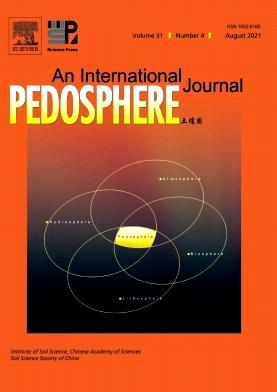Uptake and transport of montmorillonite particles by wheat
IF 5.2
2区 农林科学
Q1 SOIL SCIENCE
引用次数: 0
Abstract
Elucidation of the interactions of crop plants with clay minerals is essential for understanding the roles of clay minerals in terrestrial ecosystems. The prevailing hypothesis suggests that the physiological barriers of plant roots prevent the direct uptake of these large-size particles. However, whether crops can directly take up clay mineral particles remains unknown. Montmorillonite is a ubiquitous and important clay mineral in soil. This study used covalent fluorescence labeling and microscopic techniques to investigate the uptake and transport of montmorillonite particles by wheat (Triticum aestivum L.) in hydroponic solution, quartz sand matrix, and sandy loam soil. Additionally, the surface attachments of montmorillonite particles in xylem sap were analyzed at the nanoscale level with transmission electron microscopy and atomic force microscopy combined with infrared spectroscopy. Our results confirmed that micrometer-sized montmorillonite particles could enter the root steles of wheat seedlings from the sites of new lateral root emergence and were subsequently transported upward to the shoots and leaves through the vasculature via the transpiration stream. In this process, the surfaces of the montmorillonites adsorbed inorganic mineral nutrients and were covered by a layer of biomolecular coronas. This study reveals the potential for crop plant uptake of micrometer-sized montmorillonite particles and complements existing theories regarding the interactions of clay minerals with crop plants. Furthermore, the findings may lay a foundation for future studies on clay mineral interactions with crop plants in terrestrial ecosystems.
小麦对蒙脱石颗粒的吸收和迁移
本文章由计算机程序翻译,如有差异,请以英文原文为准。
求助全文
约1分钟内获得全文
求助全文
来源期刊

Pedosphere
环境科学-土壤科学
CiteScore
11.70
自引率
1.80%
发文量
147
审稿时长
5.0 months
期刊介绍:
PEDOSPHERE—a peer-reviewed international journal published bimonthly in English—welcomes submissions from scientists around the world under a broad scope of topics relevant to timely, high quality original research findings, especially up-to-date achievements and advances in the entire field of soil science studies dealing with environmental science, ecology, agriculture, bioscience, geoscience, forestry, etc. It publishes mainly original research articles as well as some reviews, mini reviews, short communications and special issues.
 求助内容:
求助内容: 应助结果提醒方式:
应助结果提醒方式:


